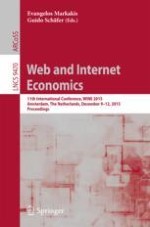2015 | OriginalPaper | Buchkapitel
Testing Consumer Rationality Using Perfect Graphs and Oriented Discs
verfasst von : Shant Boodaghians, Adrian Vetta
Erschienen in: Web and Internet Economics
Verlag: Springer Berlin Heidelberg
Aktivieren Sie unsere intelligente Suche, um passende Fachinhalte oder Patente zu finden.
Wählen Sie Textabschnitte aus um mit Künstlicher Intelligenz passenden Patente zu finden. powered by
Markieren Sie Textabschnitte, um KI-gestützt weitere passende Inhalte zu finden. powered by
